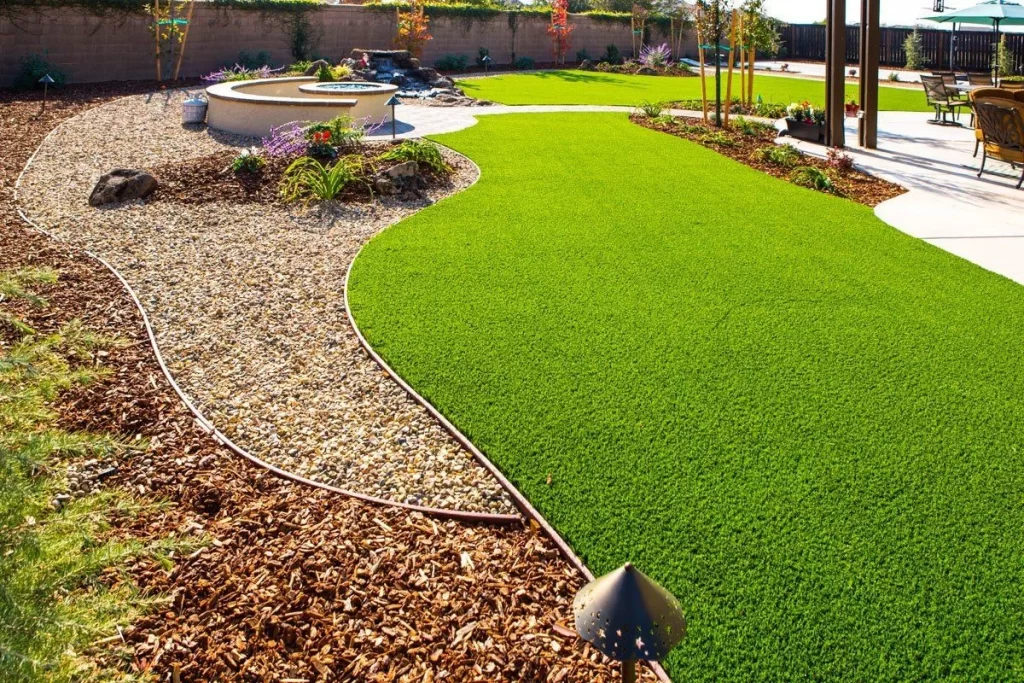
Creating a lush and vibrant lawn through landscaping grass installation is a transformative journey that enhances the beauty and functionality of outdoor spaces. A well-maintained lawn not only adds curb appeal to residential properties but also provides a welcoming environment for relaxation, recreation, and social gatherings. In this guide, we will explore the essential steps and considerations involved in landscaping grass installation, empowering homeowners to cultivate healthy and thriving lawns that elevate the aesthetics and enjoyment of their outdoor landscapes. From site preparation to seed selection and maintenance practices, each stage of the installation process plays a crucial role in achieving the desired results. Let’s delve into the key components of landscaping grass installation and uncover the secrets to cultivating a verdant and picturesque lawn that becomes the pride of your property.
Overview of the Article’s Focus on Landscaping Grass
In this article, we delve into the multifaceted world of landscaping grass, exploring its pivotal role in shaping outdoor environments and enhancing the beauty of residential and commercial landscapes. We’ll uncover the myriad benefits of landscaping grass, ranging from its aesthetic appeal to its environmental contributions. From discussing the various types of landscaping grass to providing insights into design considerations and maintenance practices, this article serves as a comprehensive guide for homeowners, landscapers, and gardening enthusiasts alike. Join us as we explore the diverse facets of landscaping grass and discover how it can transform ordinary outdoor spaces into vibrant and inviting havens of greenery and serenity.
Benefits of Landscaping Grass
Landscaping grass offers a multitude of benefits that contribute to the overall appeal and functionality of outdoor spaces. Here are some of the key advantages:
Enhanced Curb Appeal: Landscaping grass creates lush, green lawns that significantly enhance the visual appeal of residential and commercial properties. A well-maintained lawn adds aesthetic charm and creates a welcoming atmosphere for visitors and passersby.
Provides Green Spaces for Recreation and Relaxation: Grass-covered areas serve as versatile spaces for outdoor activities, leisurely strolls, picnics, and gatherings. They offer a serene backdrop for relaxation and rejuvenation, allowing individuals to connect with nature in their own backyard.
Improves Soil Stability and Water Infiltration: The root systems of landscaping grass help stabilize soil, preventing erosion and minimizing the risk of sediment runoff. Grass also promotes water infiltration, reducing surface runoff and soil compaction while replenishing groundwater reserves.
Mitigates Environmental Impact: Landscaping grass contributes to environmental sustainability by absorbing carbon dioxide and releasing oxygen through photosynthesis. It helps mitigate the urban heat island effect by reducing surface temperatures and providing cooling effects through evapotranspiration.
Supports Biodiversity: Grass lawns provide habitat and food sources for various wildlife species, including insects, birds, and small mammals. They contribute to biodiversity by supporting a diverse ecosystem of plants and animals within urban and suburban landscapes.

Types of Landscaping Grass
Landscaping grass encompasses a diverse array of species and varieties, each offering unique characteristics suited to different climates, soil types, and aesthetic preferences. Here are some common types of landscaping grass:
Cool-Season Grasses:
Examples include Kentucky bluegrass, tall fescue, and fine fescue. Cool-season grasses thrive in regions with cooler temperatures and moderate humidity levels. They exhibit excellent cold tolerance and lush green foliage during the spring and fall seasons.
Warm-Season Grasses:
Bermuda grass, Zoysia grass, and St. Augustine grass are popular warm-season grasses. They are well-suited to hot and humid climates, exhibiting optimal growth during the summer months. Warm-season grasses typically go dormant and turn brown in cooler temperatures but recover quickly in spring.
Native Grasses:
Native grasses are species that naturally occur and thrive in specific regions without requiring extensive maintenance or irrigation. They are well-adapted to local environmental conditions and provide habitat and food sources for native wildlife.
Fine-Textured Grasses:
Fine-textured grasses, such as bentgrass and fine fescue, are known for their fine blades and dense growth habit. They create a velvety appearance and are often used for golf courses, sports fields, and ornamental lawns where a manicured appearance is desired.
Drought-Tolerant Grasses:
Drought-tolerant grasses, such as buffalo grass and blue grama grass, are well-adapted to arid and semi-arid climates with limited water availability. They have deep root systems and can withstand periods of drought and water scarcity.
Shade-Tolerant Grasses:
Shade-tolerant grasses, such as creeping red fescue and fine-leaf fescue, thrive in areas with limited sunlight or partial shade. They exhibit good tolerance to low light conditions and are suitable for planting under trees or in shaded areas of the landscape.
Landscaping Grass vs. Artificial Turf: Pros and Cons Comparison
When considering landscaping options for outdoor spaces, homeowners often weigh the merits of natural landscaping grass against artificial turf. Here’s a comparison of the pros and cons of each:
Landscaping Grass:
Pros:
Natural Aesthetic: Landscaping grass provides a lush and natural look that enhances the beauty of outdoor environments.
Environmental Benefits: Grass lawns contribute to air quality improvement, carbon sequestration, and storm water absorption, promoting environmental sustainability.
Cooler Surface Temperature: Natural grass stays cooler than artificial turf, making it more comfortable for outdoor activities during hot weather.
Habitat Creation: Grass lawns support biodiversity by providing habitat and food sources for insects, birds, and other wildlife species.
Soil Health: Grass roots help improve soil structure, prevent erosion, and promote water infiltration, contributing to soil health and fertility.
Cons:
Regular Maintenance: Landscaping grass requires regular mowing, watering, fertilizing, and weed control to maintain its appearance and health.
Water Usage: Maintaining a lush grass lawn often requires significant water consumption, especially in arid and semi-arid regions.
Pest and Disease Management: Grass lawns are susceptible to pests, diseases, and turf grass issues that may require chemical treatments and interventions.
Seasonal Maintenance: Grass lawns may go dormant or turn brown during periods of drought or extreme temperatures, requiring additional care and attention to revive.
Artificial Turf:
Pros:
Low Maintenance: Artificial turf requires minimal maintenance compared to natural grass, eliminating the need for mowing, watering, fertilizing, and pest control.
Durability: Synthetic turf is highly durable and resistant to wear and tear, making it suitable for high-traffic areas and sports fields.
Consistent Appearance: Artificial turf maintains a uniform green appearance year-round, regardless of weather conditions or seasonal changes.
Water Conservation: Artificial turf helps conserve water by eliminating the need for irrigation, reducing water usage and utility costs.
Allergy Reduction: Synthetic turf minimizes pollen and allergen exposure, making it ideal for individuals with grass allergies or sensitivities.
Cons:
Artificial Appearance: Synthetic turf may lack the natural aesthetic and texture of real grass, detracting from the visual appeal of outdoor spaces.
Heat Retention: Artificial turf can become hot to the touch during sunny days, potentially causing discomfort for barefoot users and pets.
Environmental Impact: The production, installation, and disposal of artificial turf have environmental implications, including carbon emissions and waste generation.
Limited Biodiversity: Artificial turf does not support biodiversity or provide habitat for wildlife, reducing ecological diversity in outdoor environments.

Landscaping Grass Maintenance
Proper maintenance is essential for preserving the health, beauty, and longevity of landscaping grass. Here are key maintenance practices to keep your grass looking lush and vibrant:
Regular Mowing:
Maintain an appropriate mowing height based on the grass species and seasonal conditions. Avoid cutting more than one-third of the grass blade length in a single mowing session to prevent stress and promote healthy growth.
Adequate Watering:
Water landscaping grass deeply and infrequently to encourage deep root growth and drought tolerance. Water early in the morning to minimize evaporation and fungal diseases. Adjust watering frequency based on weather conditions and soil moisture levels.
Fertilization:
Apply a balanced fertilizer to provide essential nutrients for grass health and growth. Follow recommended application rates and timing based on soil test results and grass species requirements. Avoid over-fertilization, which can lead to nutrient runoff and environmental pollution.
Weed Control:
Monitor the lawn regularly for weeds and address them promptly using cultural, mechanical, or chemical control methods. Practice proper lawn maintenance techniques, such as proper mowing and watering, to minimize weed establishment and competition.
Aeration:
Periodically aerate the lawn to alleviate soil compaction and improve air, water, and nutrient penetration into the root zone. Core aeration helps promote healthy root development and overall turf vigor.
Overseeing:
Overseed bare or thin areas of the lawn with grass seed to promote thick, dense turf cover and improve turfgrass density. Choose high-quality grass seed varieties that are well-adapted to your region and site conditions.
Pest and Disease Management:
Monitor the lawn for signs of pests, diseases, and turfgrass problems. Identify and address pest and disease issues promptly using integrated pest management (IPM) strategies, including cultural, biological, and chemical control methods.
Lawn Renovation:
Periodically renovate the lawn to address soil compaction, thatch buildup, and turfgrass decline. Core aerate, dethatch, overseed, and topdress the lawn as needed to rejuvenate turf health and appearance.
Seasonal Care:
Adjust lawn care practices seasonally to meet the changing needs of the grass and environmental conditions. Perform soil testing, fertilization, and weed control in spring and fall, and adjust watering frequency and mowing height during summer and winter.
Conclusion
In conclusion, landscaping grass serves as a foundational element in outdoor environments, providing numerous benefits ranging from aesthetic enhancement to environmental sustainability. With its lush greenery and natural appeal, landscaping grass transforms ordinary yards into inviting outdoor retreats and enhances the overall quality of life for homeowners and communities.

